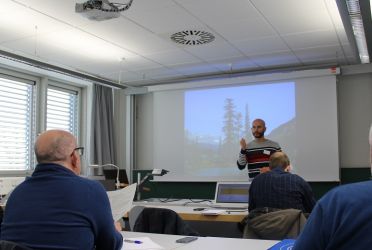The German university holds work days to analyse the different techniques used in the study of soils and plants
The University of Trier has today seen the inauguration of the work days on soil and plant sampling protocols, organised by the Diverfarming European project, with the participation of professors Beatriz Lozano and Luis Parras from the Departamento de Química Agrícola y Edafología of the Universidad de Córdobaand whose communication plan coordinates the Unidad de Cultura Científica y de la Innovación at the UCO.
 These days, which will run until Saturday the 20th, have been opened by Soren Thiele – Bruhn, professor in the department of Soil Science at the University of Trier, and the coordinator of the project and researcher from the Universidad Politécnica de Cartagena, Raúl Zornoza, who has reminded those attending of the importance of being collaborative, and stressing the coordination among the 25 participating partners, and especially among those from the same work team.
These days, which will run until Saturday the 20th, have been opened by Soren Thiele – Bruhn, professor in the department of Soil Science at the University of Trier, and the coordinator of the project and researcher from the Universidad Politécnica de Cartagena, Raúl Zornoza, who has reminded those attending of the importance of being collaborative, and stressing the coordination among the 25 participating partners, and especially among those from the same work team.
Diverfarming works in the fields to palliate the negative effects of the current system of intensive monocropping by means of crop diversification and agriculture based on the reduction in the use of resources such as water, pesticides, machinery or energy. There are 22 experimental plots (or case studies) which have been enabled to study the different crop diversification systems, in order to find the most appropriate for each zone and crop.
The over half a year that the project has been operational has enabled the network among partners to be put into practice and also to establish the design of experiments and sampling of soils and crops in these “case studies”. Now, these work days will serve to unify criteria for handling the sampling and its analysis. Thus, it will be easier to compare the samples taken in the different study fields.
To reach the goal - the definition of the different analysis methods - the leaders of each “case study” have presented the characteristics of their lands and crops to then continue the day with a debate about certain parameters which must be measured in the project. Carbon sequestration, root size, electrical conductivity or soil structure have been some of the concepts discussed.
Once the different experimental terrains and the parameters to be analysed have been described, what remains will be to reach a consensus on which sampling methods and protocols are to be used, since the soil profiles of the different lands will have to be characterised throughout this year.
More This email address is being protected from spambots. You need JavaScript enabled to view it. // + 34 660 612 154










